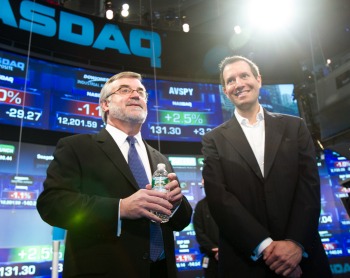
Bob Whaley and Jacob Sagi honored for the creation of Alpha Indexes
Vanderbilt finance professors Robert Whaley and Jacob Sagi rang the opening bell for Nasdaq OMX in New York on Tuesday, April 19, to celebrate the start of options trading on a new group of indexes the pair developed to help protect stock gains from market fluctuations.
Called Alpha Indexes, these new tools are designed to help investors measure performance between individual stocks and benchmark exchange-traded funds. In practice, this means that the returns of popular holdings such as Apple and Citigroup could be isolated from sharp swings in the market. Traditionally it has been difficult, if not impossible for some, to trade on the relative performance of one asset compared to another.
When investing in a stock, “you’re focusing on the fortunes of a company and you generally don’t want to predict the direction the market’s going to go,” Whaley said in an interview with CNBC from the Nasdaq exchange. “[rquote]Can there be an index or instrument that isolates firm performance relative to the market? That’s what these indices are designed to do.[/rquote]”
In a recent paper describing how relative performance indexes work, which led to the creation of the Alpha Indexes, Sagi and Whaley use the example of Apple compared to the S&P 500.
In September 2008 Apple’s share price plummeted by 32 percent, more than three times the amount lost in the broader markets. Seeing such an outsized decline in Apple’s share price compared to the market overall may have signaled a buying opportunity to some investors.
But as the financial crisis worsened, Apple’s share price fell by another 1.4 percent. During the same time, however, the broader market fell by about 16.6 percent.
“Apple outperformed the market as the investor expected,” Sagi and Whaley write. But anyone who had purchased shares of Apple, while beating the market, would still have suffered a loss.

If an investment tool based on a relative performance index had been available to capture Apple’s performance against the market, however, it would have yielded a substantial gain.
To try and replicate that same trade using the tools available at the time, an investor would have had to buy a long position in Apple, while shorting, or betting against, a product like an S&P 500 index fund.
The central risk in that scenario is that an investor would be exposed to an unlimited loss in the short position. By contrast, a relative performance index would place at risk only the original amount of the investment. Further, the money and time spent rebalancing those trades to account for volatility in both the long and short position would be too much for most investors to bear.
Sagi and Whaley see the relative performance indexes as providing an easy and low-cost way to execute what traditionally has been a cumbersome trade.
But as these indexes become more widely used, the authors say, they could introduce entirely “new return/risk management strategies to the investment arsenal.”

Sagi is Vanderbilt Financial Markets Research Center Associate Professor of Finance at the Vanderbilt Owen Graduate School of Management; and Whaley is Valere Blair Potter Professor of Management at Owen. Whaley, creator of the CBOE’s Market Volatility Index (VIX), also serves as co-director of the Financial Markets Research Center.
Vanderbilt Owen Graduate School of Management is ranked as a top institution by BusinessWeek, The Wall Street Journal, U.S. News & World Report, Financial Times and Forbes.